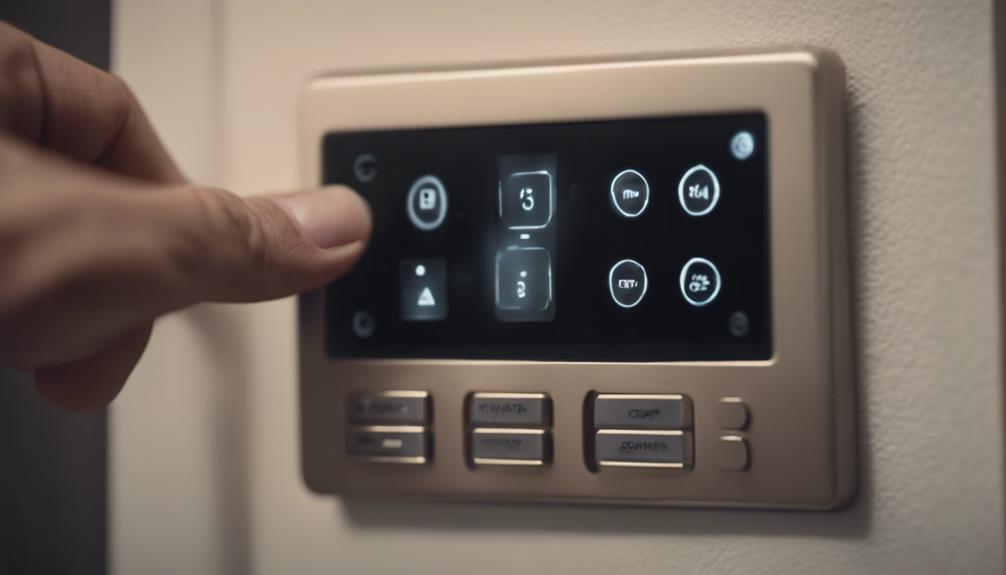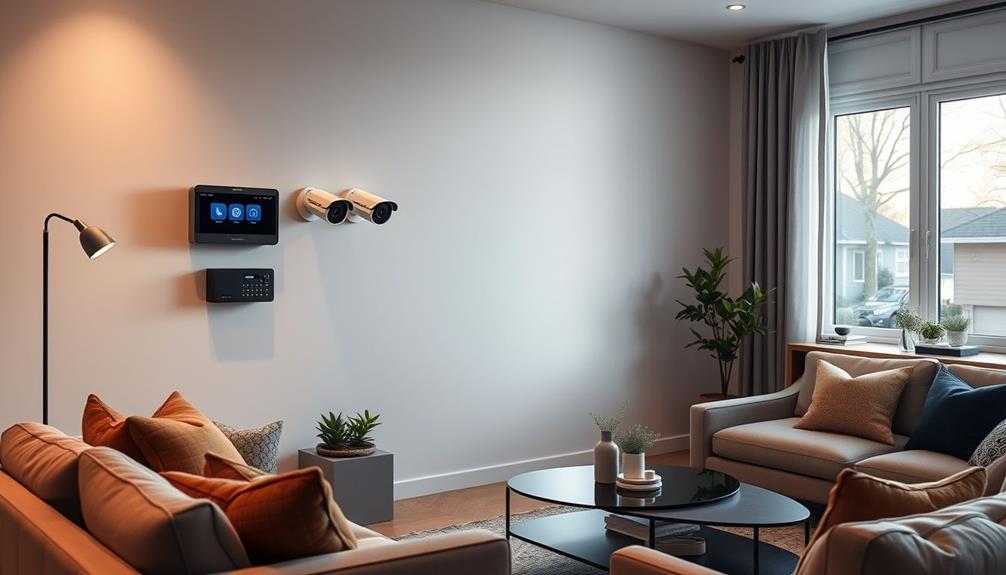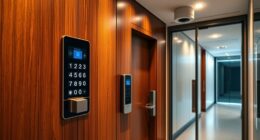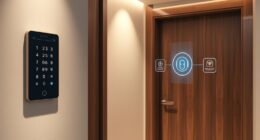To reset the password on your home security system, first, access the app or website and find the Login Information section. Use the "Forgot Your Password?" option to receive a reset link via email. If you're logged in, enter your current password and create a new one that's at least 10 characters long, including letters, numbers, and special characters. After saving your new password, consider logging out of all devices for added security. If you run into issues, customer support can offer further assistance, and there's more info to help guarantee your system stays secure.
Key Takeaways
- Access the security system app or website and locate the Login Information section to initiate the password reset process.
- Utilize the "Forgot Your Password?" feature to receive a reset link via email if you cannot remember your current password.
- Create a new password that is at least 10 characters long, including letters, numbers, and special characters to meet security requirements.
- Log out of all devices after resetting your password to enhance security and prevent unauthorized access.
Importance of Password Management
Effective password management is essential for safeguarding your home security system and preventing unauthorized access. You need to create strong, unique passwords that are different from any you've used before. Aim for at least 10 characters, mixing letters, numbers, and special characters. This combination greatly enhances your security.
Additionally, utilizing AI-driven solutions can help in automating the security protocols of your system, enhancing overall efficiency and protection against potential breaches. For instance, AI in Cybersecurity can enhance threat detection and response times, which is crucial in maintaining the integrity of your home security.
Regularly updating your passwords is another key aspect of effective password management. Security experts suggest changing them every 3 to 6 months to minimize the risk of unauthorized access. If you forget your password, you could face access challenges and even potential breaches.
To avoid these issues, securely document your passwords. Consider using a password manager, which can help you store and retrieve your credentials easily. This way, you won't have to rely solely on memory, reducing the chances of temporary lockouts after multiple incorrect attempts.
Common Password Issues

Common password issues can lead to frustrating lockouts and hinder your ability to access your home security system when you need it most. One of the most prevalent problems you might face is forgetting your password, which often results in temporary lockouts after multiple failed login attempts.
Even if you create a new password, mistyping or not meeting the system's security requirements can complicate access further. Additionally, just as cats exhibit signs of attachment to their owners, you may feel a strong connection to your home's security, making it even more crucial to resolve these issues promptly.
You may also struggle with security questions during the recovery process. If you can't easily recall the answers or have forgotten them altogether, regaining access can become an intimidating task. Specific devices, like Samsung Galaxy models, often present challenges for users trying to access secure folders or features due to lost login credentials.
To avoid these common password issues, it's important to document your passwords securely. Many users find themselves in tough situations simply because they didn't keep track of their login information.
Resetting Your Password

If you're facing difficulties accessing your home security system due to a forgotten password, resetting it can quickly restore your control.
Understanding the importance of emotional stability, much like managing relationships with BPD-coded characters, can also help you approach password management with a calm mindset.
Here's how you can go about resetting your password effectively:
- Access the App or Website: Go to your home security system's app or customer website and navigate to the Login Information section.
- Use the "Forgot Your Password?" Feature: If you can't remember your current password, click on the "Forgot your password?" link. You'll receive a password reset link via email after answering your security question.
- Set a New Password: Enter your new password, ensuring it meets the minimum requirements: at least 10 characters, including one letter, one number, and one special character.
- Log Out All Devices: Once you've reset your password, log out of all devices. This step enhances security and prevents unauthorized access.
For specific instructions related to different models, consult your user manual or reach out to customer support.
Using the Alarm.com App

To manage your home security system easily, start by logging into the Alarm.com app and guiding to the 'Login Information' section.
Here, you'll find the option to reset your password. It's important to guarantee your home is equipped with essential kitchen gadgets that can enhance your overall home efficiency.
First, enter your current password in the 'Current Password' field. Then, type your new password into the 'New Password' field. Make sure your new password meets the required criteria: it should be at least 10 characters long and include at least one letter, one number, and one special character.
Once you've entered your new password, the app will offer you the option to log out all devices before saving changes. This step enhances the security of your home alarm system, guaranteeing that nobody else can access your account with the old password.
If you run into any issues during this process, you can always select the 'Forgot your password' option. This will send a reset link to your email, allowing you to regain access easily.
Using the Alarm.com Website

Accessing your home security system through the Alarm.com website provides another straightforward method to reset your password. The process is designed to be user-friendly, ensuring that you can efficiently manage your account even if you're not tech-savvy. Here's how you can do it efficiently:
- Log In: Start by entering your login credentials at the Alarm.com customer portal.
- Navigate to Settings: Once logged in, go to the Settings section and select Login Information.
- Enter Credentials: In the Current Password field, type your existing password, then enter your new password in the New Password field.
- Optional Security: You can choose to log out of all devices before saving your changes to enhance security.
If you've forgotten your password, don't worry! Simply click on the "Forgot your password?" link. After answering your security question, a reset link will be sent to your registered email, giving you another opportunity to set a new code. This simple process resembles the psychological impact of zodiac signs on self-perception, highlighting how straightforward steps can restore confidence.
Using the Alarm.com website for password resets is quick and user-friendly, ensuring you can regain access to your security system without hassle. Just follow these steps, and you'll be back in control in no time.
Securing Your New Password

Securing your new password is essential for protecting your home security system from unauthorized access.
Start by creating a strong password that's at least 10 characters long, incorporating a mix of letters, numbers, and special characters. This complexity makes it harder for intruders to guess.
Additionally, maintaining a holistic lifestyle can also promote mental clarity, which is beneficial when choosing and remembering passwords. Avoid using easily guessable information like birthdays or common words.
Consider using a password manager to help you generate and store your complex passwords securely. This way, you won't have to remember every detail, and you can update your password every few months to further enhance security. Regular updates minimize the risk of someone gaining access to your system.
If your security system offers two-factor authentication (2FA), enable it. This adds another layer of protection, requiring a second form of verification in addition to your password.
Contacting Customer Support

When you can't reset your password, reaching out to customer support is key.
Many celebrities like Jenna Elfman are known for their dynamic projects, and similarly, security providers often have dynamic support teams ready to assist you.
Most providers offer various channels like phone, email, and live chat, so you can pick what works best for you.
Make sure you have your account details handy to verify your identity and get the help you need.
Support Channels Available
Many home security systems provide various customer support channels, so you can easily choose the method that works best for you. Here are some common support channels you might consider:
- Phone Support: Call the customer service number for immediate assistance. This is often the quickest way to get help.
- Email Support: Send an email detailing your issue. This method allows you to describe your problem in depth, but response times may vary.
- Live Chat: Many manufacturers offer live chat on their websites. This option lets you communicate with a representative in real-time.
- Mobile App Support: If your security system has a mobile app, check for support features. You can often request help directly from your device.
Many manufacturers also have dedicated support sections on their websites, where you can find FAQs and troubleshooting guides.
Before reaching out, it's a good idea to have your model number and original purchase information ready, as this can make the process smoother.
Keep in mind that response times and support availability may differ by provider, so check their service hours and potential wait times.
Preparing for Contact
Before reaching out to customer support for a password reset, make certain you have all essential account information readily available.
Start by gathering your security system's model number and original purchase details. This info can save time and help the support team assist you more effectively.
It's also a good idea to have your personal identification ready. Some customer support representatives may need to verify your identity before they can help with the password recovery.
Be prepared to answer any security questions tied to your account, as this is often necessary for verification.
Additionally, make sure you can access the email address linked to your security account. Password reset instructions are commonly sent via email, so having that ready is vital.
While you're preparing for contact, it might help to note down any previous passwords or error messages you've encountered. This information can give the support team better insight into the issue.
Lastly, consult your user manual for any specific instructions or troubleshooting steps. Being organized and having these details on hand can make the process smoother and quicker.
Troubleshooting Login Problems

Troubleshooting login problems on your home security system often starts with addressing forgotten passwords and ensuring accurate entry to avoid lockouts. Here are some steps you can take to resolve these issues:
- Reset Your Password: If you can't remember your password, use the system's password reset option. This usually involves answering security questions or receiving a reset link via email. Make sure to check your spam folder for the email.
- Check for Lockouts: If you've entered the wrong password several times, you might be temporarily locked out. Wait for the specified time before trying again, or consult your manual for specifics.
- Contact Customer Support: If the standard reset methods don't work, reach out to customer support. They can guide you through advanced troubleshooting and help you regain access.
- Ensure Backup Battery Functionality: If your system isn't responding, check the backup battery. A low battery can cause login issues, so make sure it's charged or replaced.
Best Practices for Future Access

To keep your home security system safe, it's essential to use effective password storage techniques and update your passwords regularly.
By securely storing your passwords and renewing them every few months, you can greatly reduce the risk of unauthorized access.
Let's explore how to implement these best practices for future access.
Secure Password Storage Techniques
Utilizing a password manager can greatly simplify the secure storage of your passwords while keeping them protected from unauthorized access. These tools not only encrypt your passwords but also make it easy to generate a new code for each device or service you use.
To enhance your password security, consider these best practices:
- Unique Passwords: Create a unique password for each account. This way, if one gets compromised, others remain safe.
- Complexity: Use a mix of upper and lower case letters, numbers, and special characters. Avoid obvious choices like birthdays.
- Two-Factor Authentication (2FA): Whenever possible, enable 2FA. This adds an extra layer of security, requiring a second form of verification alongside your password.
- Physical Backup: Keep a written record of your passwords in a secure location, like a locked safe. This guarantees you have access if technology fails.
Regular Password Updates
Regularly updating your home security system password is essential for maintaining strong protection against potential breaches. Aim to change your password every 3-6 months to considerably enhance your security and prevent unauthorized access to your alarm systems.
When you create a new password, make sure it's at least 10 characters long and includes a mix of letters, numbers, and special characters. This complexity makes it much harder for intruders to guess.
To help manage your passwords, consider using a password manager. This tool can securely store and generate unique passwords, reducing the chances of forgetting or reusing passwords across different accounts.
Additionally, enabling two-factor authentication (2FA) adds an extra layer of security, requiring a second form of verification beyond just your password.
Lastly, document your password changes in a secure location. This ensures you can easily retrieve your new password when accessing your home security system in the future.
Frequently Asked Questions
What to Do if You Forgot Your House Alarm Code?
If you've forgotten your house alarm code, check the user manual for a default code. You can also try a keypad sequence or contact your alarm provider for assistance in recovering your access.
How to Reset Home Security System?
So, you're locked out of your own fortress? Don't worry! Check your manual for reset steps, enter your secret codes, or just hit the factory reset—just remember, you'll need to set everything up again!
How to Reset Security Alarm Without Code?
To reset your security alarm without a code, unplug the backup battery and power source. Wait a few minutes, then reconnect everything. If needed, consult your manual for specific reset instructions for your model. After reconnecting the battery and power source, your system may automatically reset or prompt you to follow additional steps. If you need to reset Brinks home security system models, follow the specific instructions provided in the user manual to ensure a successful reboot. In some cases, you may also need to contact customer support for assistance if the reset process does not resolve the issue.
How Do I Reset the Password on My Security Camera?
Imagine the flickering light of your security camera. To reset your password, find the tiny reset button, hold it for ten seconds, or use the app's settings to change it easily. You've got this!
Conclusion
In summary, keeping your home security system secure starts with effective password management.
By resetting your password and following best practices, you can safeguard your home like a fortress.
Remember, a strong password is your first line of defense against intruders.
If you ever run into trouble, don't hesitate to reach out for help.
Stay vigilant, and your home will remain a haven of safety and peace.
You've got this!









